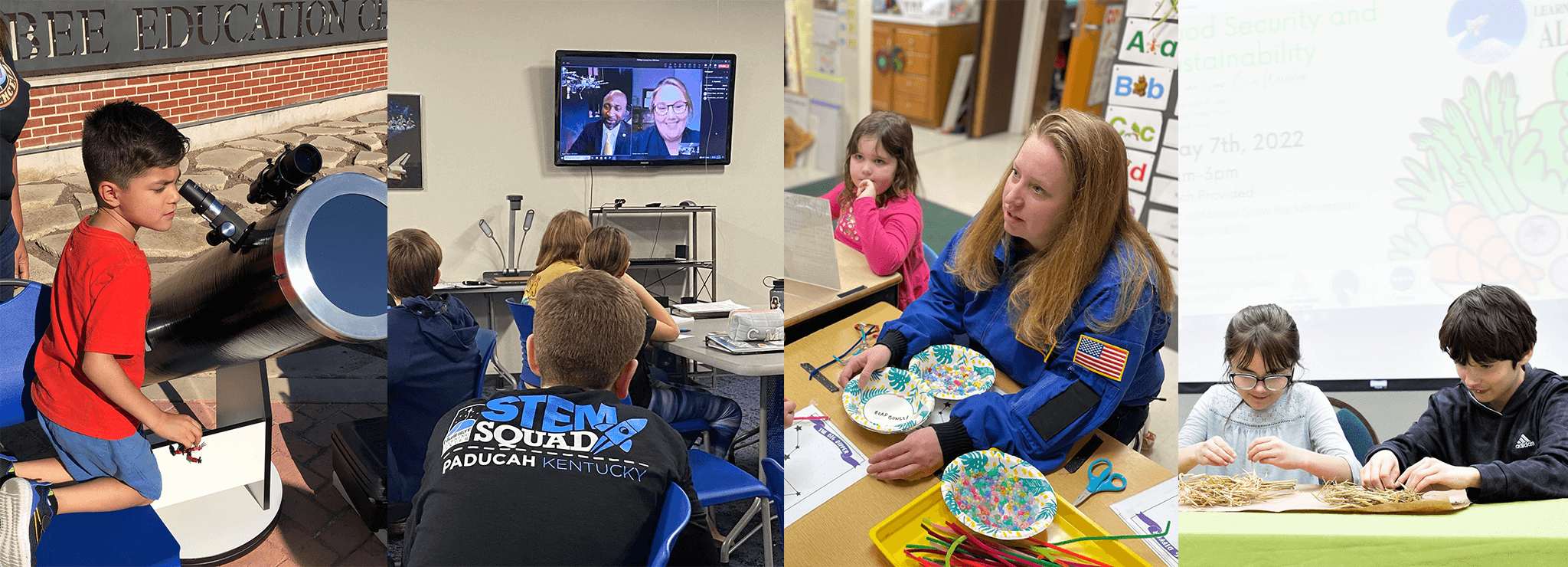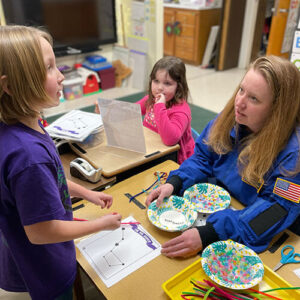Blogs | 6.14.2023
Connecting Underserved Communities to STEM and Space Exploration

As part of NASA’s Next Gen STEM project, the Community Anchor Award helps NASA share its mission and future exploration plans with a diverse audience. It’s designed to establish and nurture connections between local communities and NASA’s most exciting missions and milestones, bringing the excitement of space exploration to traditionally underserved areas and increasing student interest in STEM fields—helping reach young people in communities NASA might not otherwise reach.
The Inaugural Class
An initial set of 21 one- to two-year projects, across 16 states, were selected for the Community Anchor Award in 2021, with projects starting in February 2022. These projects serve diverse populations, including students from groups traditionally underrepresented in STEM, urban and rural areas with low economic opportunity, Tribal communities, and new Americans and refugees.
Four Challenger Learning Centers were awarded funds through NASA’s inaugural class. While their approach to engaging their communities in STEM has been different, the end goal remains the same: provide students and community members with STEM information they can use now and in their futures …
Challenger Learning Center of Alaska
 Historically, Alaska imports 95% of its food supply, while grocery stores tend to keep just a 3–5-day reserve. And growing and preserving healthy food in harsh climates—permafrost, short hot summers, and long arctic winters—is a struggle for many Alaskans. The demand for fresh food, in addition to high shipping costs, increases prices and makes it extremely difficult for the average Alaskan family to afford healthy foods.
Historically, Alaska imports 95% of its food supply, while grocery stores tend to keep just a 3–5-day reserve. And growing and preserving healthy food in harsh climates—permafrost, short hot summers, and long arctic winters—is a struggle for many Alaskans. The demand for fresh food, in addition to high shipping costs, increases prices and makes it extremely difficult for the average Alaskan family to afford healthy foods.
With the NASA Community Anchors Award funding, Challenger Learning Center of Alaska collaborated with local growers and harvesting experts to create a 3-part community program about food security and sustainability:
- Growing Your Own: Experts discussed the science of growing food in the ground, green houses, hoop houses, and raised beds. Locals demonstrated how to make worm beds, soil mixtures, and composts. Community members made their own self-watering grow buckets and learned how to save their own seeds to decrease supplier dependency.
- Wild Harvesting: Participants were introduced to the variety of ways Alaskan’s can harvest fish, game, plants, and berries, including best timing and locations to harvest, limits placed on harvesting, and the laws that protect our natural resources.
- Preservation: Experts will teach locals about food preservation methods like, freezing, pressure cooking versus water-bath canning, dehydrating, smoking, fermentation, and pickling. Attendees will partake in a cold storage design challenge.
The Center will also develop a webpage compiling local resources for additional food security information.
Despite Alaska’s harsh climate, there is an abundance of natural resources available to Alaskans. This Food Security and Sustainability series offers an opportunity for them to ease into being comfortable securing their own food. They’ll learn how simple it can be once they understand the fundamentals and are given a starting point to take their first steps.
Challenger Learning Center at Paducah
 NASA’s Community Anchor Award funding allowed Challenger Learning Center at Paducah to establish STEM Squad, a program that provides students in rural Kentucky with ongoing STEM and space-themed experiences. Thirty 5th-8th grade students were selected last fall during a competitive application process.
NASA’s Community Anchor Award funding allowed Challenger Learning Center at Paducah to establish STEM Squad, a program that provides students in rural Kentucky with ongoing STEM and space-themed experiences. Thirty 5th-8th grade students were selected last fall during a competitive application process.
During monthly virtual and in-person meetings, the STEM Squad has learned about topics like the effects of space on the body, how to build an ISS model, and sea levels; as well as experienced the Center’s portable planetarium, STARLAB. When given the opportunity to chat with two NASA employees—both natives of West Kentucky—students were exposed to careers they may otherwise have never learned about. Terence Williams shared his work as the Operations Directorate, European Service Module Integration Lead, and as Risk Coordinator for Orion and Gateway. Rebecca Wingfield spoke about being NASA’s 92nd Flight Director. They both shared stories of mentorship . . . Terence was Rebecca’s mentor when she first started working at NASA.
This summer, the STEM Squad will learn and engage in projects about NASA’s Artemis program. If all program attendance and assignment requirements are met, the group will attend the Pathfinder Program at Space Camp® in September.
STEM Squad has provided an in-depth, continuous STEM experience for these students; with resources, opportunities, and paths now available to them to pursue volunteer and mentorship opportunities at the Center, as well as a future STEM career.
Challenger Learning Center at the Scobee Education Center, San Antonio College
 With a population of nearly 1.5 million, San Antonio is ranked 105th in education compared to other urban centers, as of 2022. The San Antonio Current reported that the city is the least educated of Texas metropolitan areas.
With a population of nearly 1.5 million, San Antonio is ranked 105th in education compared to other urban centers, as of 2022. The San Antonio Current reported that the city is the least educated of Texas metropolitan areas.
The Challenger Learning Center at the Scobee Education Center, San Antonio College, was selected as a NASA Community Anchor awardee for their La Fiesta del Sol project with the goal of preparing area educators and students for the annular and total solar eclipse events in 2023 and 2024. The Center is:
- Educating and preparing STEM teachers and Girl Scouts leaders through pre-ellipse workshops, so they may then prepare students in their underrepresented communities. Even before the grant was awarded, the Center curated more than 20 hands-on activities designed within the STEAM framework for the Southwest Texas Girl Scout Council for a local sun studies patch. These activities have been widely shared with members of the American Astronomical Society and the Alamo STEM Ecosystem.
- Expanding efforts to informal educators by facilitating educator and community member training sessions that will be implemented across the Alamo STEM Ecosystem this summer as part of the NASA Museum & Informal Education Alliance.
- Engaging school districts, teachers, and students in a school-based Solar Studies Week. Community-wide efforts, like La Fiesta del Sol, are vitally important for raising the median levels of educational achievement and growing the future workforce development of San Antonio. The Center is committed to serving their community and inspiring the area’s children during these two unique solar eclipse experiences.
Challenger Learning Center of Maine
 Challenger Learning Center of Maine has diligently worked to reach underserved populations through the NASA Community Anchor Award, which initially allowed the Center to bring virtual Mars programming to 10 rural schools across the state—schools they previously had never been able to serve. The program was so well received, that the Center is now stretching their original goal to reach even more schools throughout the 2022-2023 academic year. To date, they’ve served 19 schools and provided opportunities for rural students to imagine themselves as NASA STEM professionals while improving their self-perception of their abilities to participate in STEM.
Challenger Learning Center of Maine has diligently worked to reach underserved populations through the NASA Community Anchor Award, which initially allowed the Center to bring virtual Mars programming to 10 rural schools across the state—schools they previously had never been able to serve. The program was so well received, that the Center is now stretching their original goal to reach even more schools throughout the 2022-2023 academic year. To date, they’ve served 19 schools and provided opportunities for rural students to imagine themselves as NASA STEM professionals while improving their self-perception of their abilities to participate in STEM.
Less than one week before NASA’s long-anticipated announcement of the Artemis II crew, girls across Maine gathered virtually to run their very own Moon Mission. With representation from nearly half of the counties in the state, these middle school-aged girls became mission controllers working for Blue Origin to launch the New Glenn Rocket and touch down the Blue Moon Lunar Lander on the lunar surface. The girls even received a pre-mission briefing from Lauren Konitzer, NASA Goddard Space Flight Center’s Navigation and Mission Design Engineer. Lauren passionately shared about her work, what it’s like to be a woman working for NASA, and even how she went from being a student to a NASA employee! The girls were excited to see that she was just like them at their age, allowing them to envision themselves in STEM roles and to picture themselves working for Blue Origin or NASA someday, just like Lauren.
The Mission Continues
At Challenger Center, it’s our mission to engage every student in STEM and inspire them to envision new possibilities for their futures–a mission that could not be accomplished without our network of Challenger Learning Centers and partners, like NASA. We’re proud of the work Challenger Learning Center of Alaska, Challenger Learning Center at Paducah, Challenger Learning Center at the Scobee Education Center, and Challenger Learning Center of Maine have accomplished through NASA’s Community Anchor Awards.
Dr. Carrie Olsen, NASA’s Next Gen STEM project manager, shared, “We are already hearing from the awardees on the important reach and impact they are having in communities. Their stories are truly moving. We look forward to making more Community Anchor awards through annual competitions.” More information about future funding opportunities can be found on NASA’s TEAM II Grant Forecasting webpage.
We all look forward to continuing our joint mission of inspiring the next generation!
